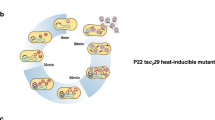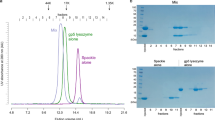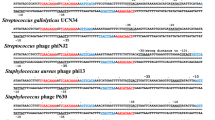Abstract
INFECTIONS of Salmonella typhimurium by wild-type phage P22 generally result in a lytic response at low multiplicities of infection (MOIs) and a lysogenic response at high MOIs1. At MOIs above 5, more than 90% of all cells are lyso-genised. At an MOI of 3, 45% of the infected cells become lysogens whereas at an MOI of 1, only 23% of the infected cells are lysogenised. The regulation of P22 lysogeny has been studied extensively1–7. Three structural genes and a cis-active site in the immunity C (immC) region are required to establish lysogeny. Interaction of gene c1 and c3 products at the c27 site stimulates the production of the c2 represser, and at the same time causes a transient retardation in the expression of lytic genes1,8. A mutant of S. typhimurium, Pox-1, that channels P22 infections at any MOI to lysogeny with an efficiency of 1.0 has a reduced capacity for both host and viral DNA synthesis6. Slowed synthesis of DNA in this mutant results in an overproduction of regulatory proteins relative to the levels of viral DNA in infected cells. This, in turn, results in lysogeny at all MOIs. We now propose that the initial decision between lysis and lysogeny in wild-type cells is also a function of the relative amounts of phage DNA and the phage proteins from the immC region.
This is a preview of subscription content, access via your institution
Access options
Subscribe to this journal
Receive 51 print issues and online access
$199.00 per year
only $3.90 per issue
Buy this article
- Purchase on Springer Link
- Instant access to full article PDF
Prices may be subject to local taxes which are calculated during checkout
Similar content being viewed by others
References
Levine, M., Virology, 3, 22–41 (1957).
Gough, M., and Tokuno, S., Molec. gen. Genet., 138, 71–79 (1975).
Levine, M., and Smith, H., Science, 146, 1581–1582 (1964).
Levine, M., and Schott, C., J. molec. Biol., 62, 53–64 (1971).
Smith, H., and Levine, M., Proc. natn. Acad. Sci. U.S.A., 52, 356–363 (1964).
Steinberg, B. M., and Gough, M., J Virol., 16, 1154–1160 (1975).
Tokuno, S., and Gough, M., J. Virol., 16, 1184–1190 (1975).
Tokuno, S., and Gough, M., Molec. gen. Genet., 144, 199–204 (1976).
Botstein, D., and Herskowitz, I., Nature, 251, 584–549 (1974).
Fry, B. A., J. gen. Microbiol, 21, 676–684 (1959).
Gough, M., Scott, J. V., Malik, V. S., and De La Rosa, O., Virology, 47, 276–284 (1972).
Denhardt, D. T., Biochem. biophys. Res. Commun., 23, 641–646 (1966).
Smith, H. O., Virology, 34, 203–223 (1968).
Author information
Authors and Affiliations
Rights and permissions
About this article
Cite this article
STEINBERG, B., GOUGH, M. Bacteriophage P22 lysogenises efficiently at high multiplicities of infection because Salmonella typhimurium DNA synthetic capacity is limited. Nature 263, 54–56 (1976). https://doi.org/10.1038/263054a0
Received:
Accepted:
Issue Date:
DOI: https://doi.org/10.1038/263054a0
This article is cited by
-
Kinetics of bacteriophage λ repressor synthesis directed by the P RE promoter: Influence of temperature, multiplicity of infection, and mutation of P RM or the cro gene
Molecular and General Genetics MGG (1980)
-
Effect of mutant host RNA polymerase on the bifunctional activities of P22 gene c1
Molecular and General Genetics MGG (1977)
Comments
By submitting a comment you agree to abide by our Terms and Community Guidelines. If you find something abusive or that does not comply with our terms or guidelines please flag it as inappropriate.



